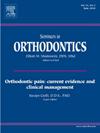What do the indigenous people of the Amazon have to teach us about the etiology of dental malocclusion?
IF 2
4区 医学
Q2 DENTISTRY, ORAL SURGERY & MEDICINE
引用次数: 0
Abstract
Studies in both human and nonhuman primates have historically linked the rising prevalence of malocclusion to changes in dietary consistency and food processing. However, the evaluation of semi-isolated indigenous populations with preserved traditional habits offers a unique opportunity to investigate the true origins of occlusal and craniofacial variation. Over more than a decade, we have evaluated five Amazon indigenous groups from the Middle Valley of the Xingu River, characterized by exclusive breastfeeding, absence of pacifier use, uniform patterns of occlusal tooth wear, and well-documented genetic profiles indicating low intratribal and high intertribal variation. The prevalence of malocclusion ranged from 33.8 % to 66.7 %, overall lower than that observed in urban Amazon populations, around 85 %. The lower prevalence of posterior crossbite may be related to prolonged breastfeeding and an absence of pacifiers in the indigenous groups. Despite cultural and environmental homogeneity, a high degree of intertribal diversity was found in occlusal features, facial morphology, dental arch dimensions, and dental crowding, while a small intragroup variation was observed. In a 13-year follow-up, dental crowding and tooth wear increased, while the arch dimensions tended to decrease, suggesting that the effect of increased tooth wear on the etiology of tertiary crowding is of small magnitude and restricted to the lower dental arch. These findings suggest that genetic factors play a central role in determining the dentofacial characteristics, challenging the theory that diet consistency could be the principal cause of modern malocclusion. The evidence from these indigenous populations supports the view that occlusal and craniofacial morphology are primarily influenced by polygenic inheritance, with environmental factors contributing selectively to specific dentoalveolar traits.
关于牙齿错颌的病因学,亚马逊的土著人教给了我们什么?
从历史上看,对人类和非人类灵长类动物的研究都将错颌畸形的患病率上升与饮食一致性和食物加工的变化联系起来。然而,对保留传统习惯的半隔离土著人群的评估提供了一个独特的机会来调查咬合和颅面变异的真正起源。十多年来,我们对来自新谷河中谷的五个亚马逊土著群体进行了评估,这些群体的特点是纯母乳喂养、不使用奶嘴、咬合牙齿磨损的均匀模式,以及有充分记录的基因谱,表明部落内差异很小,部落间差异很大。错牙合的患病率从33.8%到66.7%不等,总体低于亚马逊城市人口的85%左右。后牙合发病率较低可能与土著群体中母乳喂养时间较长和缺乏奶嘴有关。尽管文化和环境具有同质性,但在咬合特征、面部形态、牙弓尺寸和牙齿拥挤度方面,部落间存在高度多样性,而在群体内则存在较小的差异。在13年的随访中,牙齿拥挤和牙齿磨损增加,而牙弓尺寸有减小的趋势,表明牙齿磨损增加对三级拥挤病因的影响较小,仅限于下牙弓。这些发现表明,遗传因素在决定牙面特征方面起着核心作用,挑战了饮食一致性可能是现代错牙合主要原因的理论。来自这些土著人群的证据支持这样的观点,即咬合和颅面形态主要受多基因遗传的影响,环境因素选择性地影响特定的牙槽特征。
本文章由计算机程序翻译,如有差异,请以英文原文为准。
求助全文
约1分钟内获得全文
求助全文
来源期刊

Seminars in Orthodontics
DENTISTRY, ORAL SURGERY & MEDICINE-
CiteScore
2.20
自引率
4.80%
发文量
28
审稿时长
10 days
期刊介绍:
Each issue provides up-to-date, state-of-the-art information on a single topic in orthodontics. Readers are kept abreast of the latest innovations, research findings, clinical applications and clinical methods. Collection of the issues will provide invaluable reference material for present and future review.
 求助内容:
求助内容: 应助结果提醒方式:
应助结果提醒方式:


